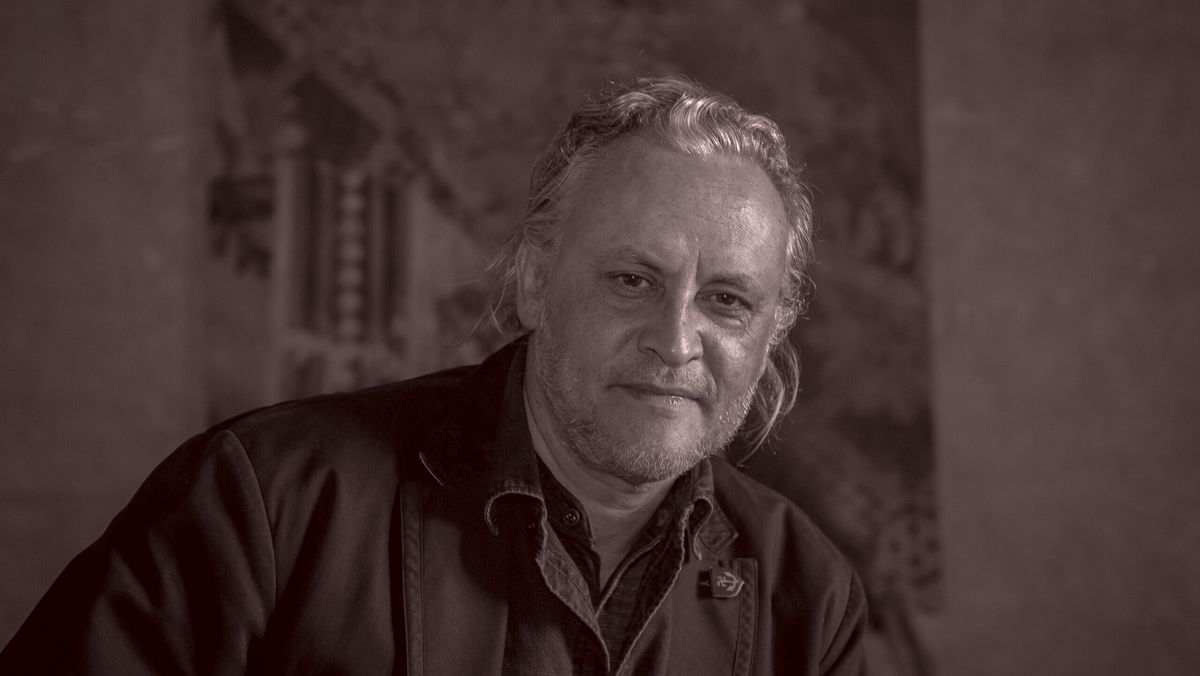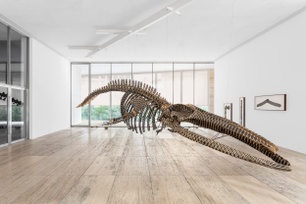Welcome back to Wall Power. I’m Marion
Maneker.
With so many folks in Mexico City, I wanted to look at the latest Gabriel Orozco retrospective that just opened at the Museo Jumex. Then I noticed that the Royal Academy in London has a new show about Brazilian modernism. So I thought I would examine both briefly for a fresh perspective. Julie Davich, our roving art market correspondent, also
stopped by the RxArt gala and Salon Art + Design’s new pop-up; she also spent some time at the Hill Art Foundation’s group show curated by Hilton Als.
But first, some breaking news…
|
- Artsy layoffs: Earlier this morning, online art brokerage Artsy laid off all 15 employees on the secondary-market sales team. The only silver lining: They were allowed to keep their laptops.
It appears the company, whose main business is a marketplace that allows galleries to sell online, had to make a choice about where to invest its resources. “Product and tech investments are needed to successfully scale this business,” the secondary sales
team was told, “and at this point in time we need to focus on improving our partner experience and growing the core marketplace.” Artsy’s press team did not immediately respond to my emails, texts, or phone calls for comment.
|
|
|

|
Julie Brener Davich
|
|
- RxArt’s starry
night: On Wednesday night, I swung by The Pool for the 25th anniversary gala of RxArt, the nonprofit founded by Diane Brown to bring art into pediatric hospitals. The therapeutic value of art—like Takashi Murakami flowers in a C.T. scan room, or a corridor adorned with Nicolas Party’s colorful cotton-candy trees—is now widely acknowledged, but that wasn’t always the case. In its early days, the organization received
support from Agnes Gund, whom Brown thanked for her “encouragement when everyone else told me I was crazy.” Today, RxArt boasts 66 projects with 96 artists in 44 hospitals in 27 cities.
|
Photo: Billy Farrell/BFA.com
|
- Brown credited the artworks she has placed with bringing smiles to the faces of young patients, or at least some much-needed distraction, and thanked the artists who are “the backbone of RxArt.” Indeed, I’ve never been in a single room with as many big-name artists as I was on that night: Eli Sudbrack, Will Cotton, Michele Oka Doner, Marcel Dzama, Shara Hughes, Jeff Koons, Ryan
McGinley, and Rob Pruitt, to name just a few. Timothy Greenfield-Sanders commemorated the occasion with a group photo (see above).
On display at the gala were several limited editions available for sale to support RxArt, including prints by Loie Hollowell, Ewa Juszkiewicz, Hilary Pecis, and this
year’s contributing artist, Ed Ruscha. The event also marked the arrival of Katie Hollander as the organization’s new director, a role that’s been vacant since Megan Skidmore departed two years ago to join Powerhouse Arts. (Previously, Hollander was the chief development officer at the Jewish Museum.) RxArt’s future projects include Mickalene Thomas in South Brooklyn; Jonas Wood in Boston; and Alexis
Rockman in Cincinnati.
|
- Salon Art + Design’s Bergdorf pop-up: Bergdorf Goodman’s seventh floor, a jewel box of designer homewares, now also boasts a small pop-up design fair from Salon Art + Design, the fair that takes place every autumn at the Park Avenue Armory. Six galleries who participated in the fair’s most recent edition each have an alcove in the hallway that runs the length of the store, painted with a different limewash by Color Atelier. “We’ve been getting a lot of people who don’t normally
come,” said Bergdorf Goodman sales rep Kelly Fraser, “like Instagrammers.”
If you go, go for the ceramics. “Ceramics are having a moment,” Fraser told me. Liz O’Brien gallery is featuring black and white ceramics from Bill Hudnut, Isobel Egan, Zachary Zimmerman, and—my favorite—several brutalist vessels from R.A. Pesce priced from $1,750 to $6,000. Verso is also showing ceramics, but their hero piece is
the serpentine lavender powdercoat chair by Matthew Day Jackson, available for $14,250 in an edition of 10, plus two artist’s proofs. The other participating galleries are J. Lohmann, Room 57, Onishi, and Galerie Gabriel. “It’s early days,” said Fraser, “but we’ve sold a lot.” The pop-up is on view until April 13.
|
The Writing’s on the Wall
|
“We handed over the space and the collection to Hilton,” Hill Art Foundation
executive director Sarah Needham told me this week, referring to the writer and critic Hilton Als. Apparently, Als was supposed to put together a solo presentation of photographs by Robert Bergman, “but he ended up going in a different direction,” Needham laughed.
The resulting group exhibition, on view through March 29, is titled The Writing’s on the Wall: Language and Silence in Visual Arts, and focuses
on themes of writing and erasure. Als brought together works from the foundation’s founders, J. Tomilson and Janine Hill, with loans from galleries and a few works from his own personal collection. Needham recalled how Als showed up with artworks in his backpack the day before the show opened—like Larry Wolhandler’s small bronze bust of James Baldwin—and just started physically placing pieces around the Peter
Marino–designed space. “Measurements are not really his thing,” she conceded.
Some of the artworks, like the Cy Twombly chalkboard painting and the Vija Celmins pink eraser sculpture, fit clearly into the show’s theme of “language itself [as] a primary visual medium,” as Holland Cotter put it in The New York Times. Others require deeper reflection, like Jennie C. Jones’s red wall installation
featuring an acoustic panel. All three works come from the Hills, who are known for acquiring in four categories: Renaissance and Baroque bronzes, Old Masters, modern art, and contemporary art, including one of the largest, if not the largest, collection of works by Christopher Wool. (The Hills opened the foundation in 2019 as a public exhibition and education space; it also happens to be a great tax write-off.)
In addition to drawing from the foundation’s
holdings, Als called in loans of specific works he knew he wanted to include in the show, like Ellen Gallagher’s DeLuxe, a grid of 60 prints based on vintage advertisements from African American magazines. Other works he found by telephoning galleries and asking if they had any artists that incorporate language. That led him to Rachel Harrison’s 2021 sculpture with a found typewriter, Hermes, from Greene Naftali gallery, and Ina
Archer’s 2024 video installation Black Black Moonlight: A Minstrel Show, from Microscope Gallery. Whether there was a method to Als’s madness, or madness to his method, it worked.
The next show at the Hill Art Foundation, opening in May, is curated by artist Sam Moyer. It will feature works of hers from the Hills’ collection, as well as others’ works from the collection that speak to her. Meanwhile, Als also curated an Alice Neel
exhibition at Victoria Miro gallery, which is on view through March 8.
|
|
|
Two new shows—Orozco in Mexico City and an enlightening survey of Brazilian
modernists in London—make yet another case for gazing far beyond Europe.
|
|
|
Zona Maco, the Mexico City art fair that opened earlier this week, has flooded
my Instagram feed with images of long-table lunches, multicolored booths, and special events held around the city, which has become an art destination over the past several years. The pandemic certainly accelerated interest in Mexico City, where a number of Americans took refuge during that time. But the city has a long history as an art capital, dating to the female surrealists who lived there during the 1940s and are now in vogue, or Elizabeth Catlett, the artist who
taught there for decades and whose retrospective just closed at the Brooklyn Museum. Meanwhile, as many museums do when a well-established fair lures so many art world professionals to town, the Museo Jumex opened a retrospective. This one is Gabriel Orozco: Politécnico Nacional.
For a number of reasons, including but not limited to the fact that I just don’t do well at altitude, I did not
go to Zona Maco. But to mark the occasion, I’m writing about Mexico City’s Orozco show as well as a new show at London’s Royal Academy of Art: Brasil! Brasil! The Birth of Modernism, which traces the unique path of 10 representative modern artists.
Don’t mistake my intention here: I’m not trying to flatten the distance and differences between Mexico and Brazil, or between Orozco and his South
American modernist predecessors. Instead, Zona Maco’s appeal as a vanguard space where art and design converge provides a convenient and connective excuse to appreciate the extraordinary range and vitality of what we consider art.
|
Gabriel Orozco: Politécnico Nacional
|
Orozco emerged in the 1990s, the child of two Mexican artists; he moved to
Spain because he found the art education in Mexico too conservative, and has since lived in a number of cities around the globe. In many ways, he is a fairly representative postmodern artist—his work is syncretic and worldly, and it speaks with a vocabulary that is truly international. He also makes so many different kinds of pieces—from whale skeletons to tabletops filled with objects to oval billiard tables with no pockets—that it’s impossible to categorize him. One of his most famous works is
a surgically reduced Citroën DS, narrowed by a third but otherwise eerily intact.
According to curator Briony Fer, who worked closely with Orozco to assemble, organize, and present the 300 objects in this show, the artist views himself primarily as sculptor—“which presumes a very expansive sense of what sculpture is,” as Fer wrote in an accompanying booklet. Be that as it may, some of the artist’s best works are paintings that mix his interest
in rules-based outcomes with abstraction, or simply overlay geometric patterns on photographs or maps with striking and memorable results.
|
Gabriel Orozco, Dark Wave (2006). Photo: Gerardo Landa & Eduardo López (GLR
Estudio)
|
As if Orozco’s output weren’t already difficult enough to categorize, the show
adds yet another element to complicate any taxonomy. The Jumex retrospective is organized not chronologically, but rather in stratified layers based on the artist’s own “groupings of material objects in time and space.” The top floor is “floating, aerated and streamlined matter.” One flight below is “vegetal, an entanglement of life-matter, ranging from the primordial through to the artifice of gardens.” The ground floor is “an aquarium but also … a ground of action, leading onto the
dry world of the terrace that is also a sculpture garden.” Beneath all of this is a basement gallery that is meant to function as the “compost, a composite of ideas and voices.” In case you haven’t been paying attention, the intent here is to create an ecosystem of air, earth, and water where Orozco’s ideas can circulate—or the viewer can circulate within them.
If all of that is too abstract and high-minded for you, the
simple beauty of Orozco’s objects makes it easy to jettison the lofty concepts and simply enjoy the atavistic pleasures of his river stones carved with circles and lines, or his found objects arranged in forms that reflect his interest in geometry or have recursive geometric forms painted on them.
|
Brasil! Brasil! The
Birth of Modernism
|
The Royal Academy of Arts’ new show of 130 works by 10 artists who define
Brazilian modernism provides the other bookend to understanding how modernity emerged in Latin American art. Whereas Orozco is a conceptual artist, these Brazilians—five with formal training and five whom we would still think of as outsider or self-taught artists—forged a distinctive modernism that set up the neo-concrete abstraction that Brazil is best known for.
Organized by the Zentrum Paul Klee,
the Royal Academy’s show began five years ago when the team of curators worked on a large, three-venue Paul Klee retrospective in Brazil. The huge public response to Klee in Brazil provoked the museum to mount a show that would introduce Brazilian modern artists from the first half of the 20th century to European viewers. The rest of us could use some of the same education.
The Royal Academy isn’t new to exhibiting works
by these artists. In 1944, it hosted the first, and probably still the largest, show of Brazilian modern art in Britain. Then, 168 works were offered for sale, with funds supporting Royal Air Force veterans. Four paintings by three artists from that original show are included in the current one, the R.A.’s current president, Rebecca Salter, proudly writes in the exhibition catalogue.
As the catalogue notes, Brazilian modernism
emerged in two almost contradictory phases. The first was a group of wealthy Brazilians who went to study art in Europe and came back deeply affected by expressionism and European modernism’s juxtaposition of a frenzied, enervated urban life with the fantasy of the unspoiled immediacy of indigenous life. The show documents artists like Anita Malfatti, who studied in Berlin but returned to Brazil in 1914 to find that her family and local critics were scandalized by her embrace of
expressionism. A decade later, she settled in Paris briefly before returning to a slightly less hostile São Paulo. Vicente do Rego Monteiro also shuttled between Paris and Brazil, equally pursuing writing and painting.
Tarsila do Amaral may seem the most strikingly familiar to viewers accustomed to contemporary art. Several of her works from the late 1920s bear a
striking resemblance to the distorted limbs and body parts of Louise Bonnet. A coffee heiress, do Amaral fled a failed marriage to become an artist and eventually studied in Paris. Her landscape paintings will also be familiar to collectors who recently fell for the Italian painter Salvo.
Candido Portinari, also born on a coffee plantation, was one of the few
Brazilian modernists trained in Europe with a working-class background. There’s also Lithuania-born Lasar Segall, who moved to São Paulo briefly as a young man but returned a decade later after having been active as an expressionist painter in Berlin. Still other figures included in the show are Flávio de Carvalho, Geraldo de Barros, and Rubem Valentim.
|
Lasar Segall, Banana Plantation (1927). Courtesy of Royal Academy of Arts
|
The other half of Brazilian modernism, the exhibition contends, emerged from a
new generation who had not studied in Europe. Around 1950, that second generation of modern artists began to address “themes characteristic of the Brazilian context,” especially race, religion, and work. Reversing the modernist fantasy of an unspoiled natural state, these Brazilian painters, especially some of the self-taught artists like Alfredo Volpi and Djanira, were able to incorporate Brazil’s close proximity to indigenous people and
cultures into their increasingly modern and sometimes abstract art. That allows the show to chart a path from expressionism to abstraction that is familiar to European eyes, but also entirely novel.
Both Brazil’s and Mexico’s contributions to modern and contemporary art are hardly unrecognized, but the increasing depth of our exposure and understanding of their art history continues to be a source of fascination
and inspiration to further study.
|
The Sotheby’s Stradivarius Julie
wrote about sold for $11.25 million today.
Also, The Atlantic is reporting that President
Trump is planning to dismiss multiple members of the board of the Kennedy Center, possibly even replacing Carlyle co-founder David Rubenstein, the current board chairman, with himself.
Talk Sunday,
M
|
|
|
Puck founding partner Matt Belloni takes you inside the business of Hollywood, using exclusive reporting and
insight to explain the backstories on everything from Marvel movies to the streaming wars.
|
|
|
The ultimate fashion industry bible, offering incisive reportage on all aspects of the business and its biggest
players. Anchored by preeminent fashion journalist Lauren Sherman, Line Sheet also features veteran reporter Rachel Strugatz, who delivers unparalleled intel on what’s happening in the beauty industry, and Sarah Shapiro, a longtime retail strategist who writes about e-commerce, brick-and-mortar, D.T.C., and more.
|
|
|
Need help? Review our FAQ page or contact us for assistance. For brand partnerships, email ads@puck.news.
You received this email because you signed up to receive emails from Puck, or as part of your Puck account associated with . To stop receiving this newsletter and/or manage all your email preferences, click here.
|
Puck is published by Heat Media LLC. 107 Greenwich St, New York, NY 10006
|
|
|
|










